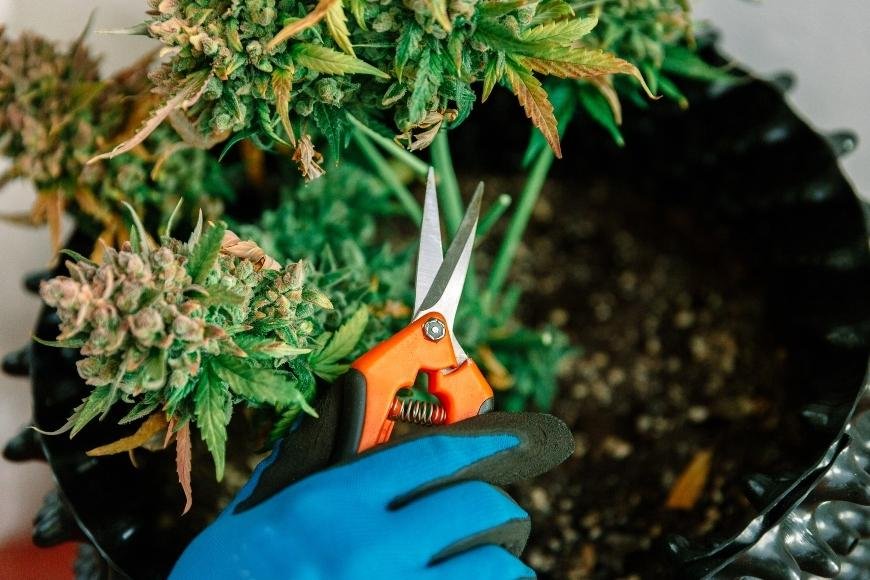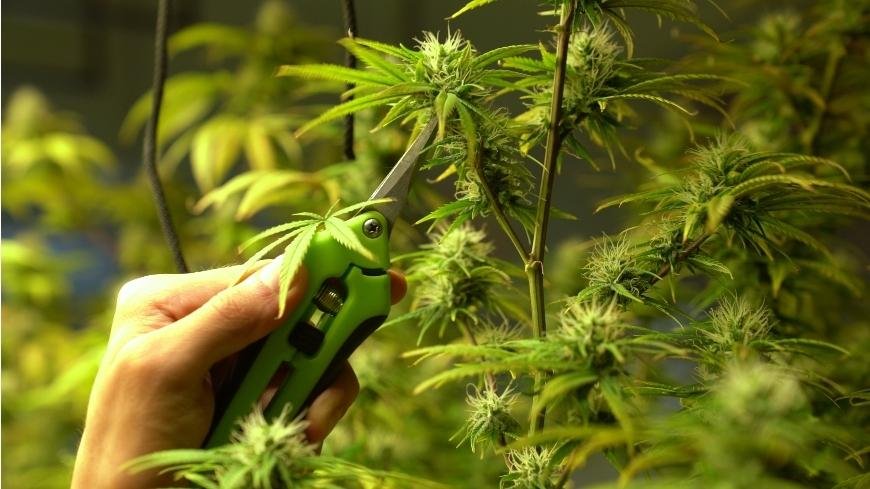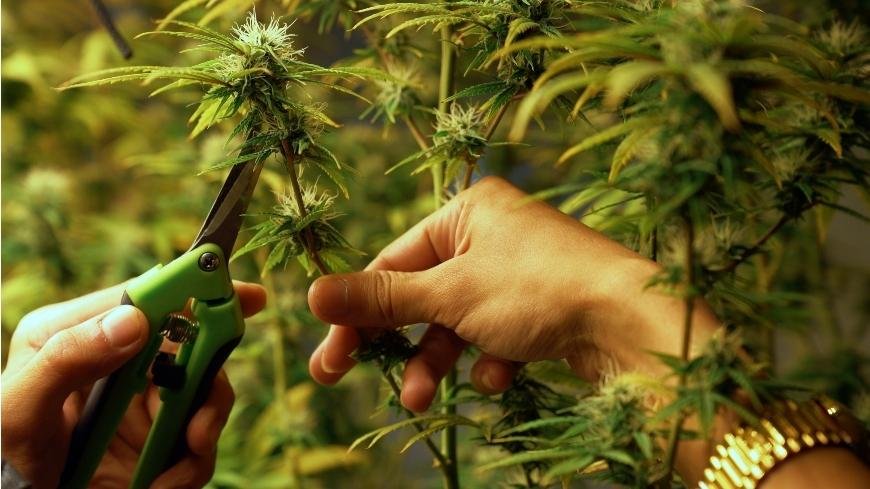Lollipopping Cannabis Plants: How To
Master Lollipopping Cannabis: How To get bigger, healthier buds with our simple technique, step-by-step guide, and mistake-avoidance tips.

If you're interested in maximizing the yield and potency of your cannabis plants, then learning about "Lollipopping Cannabis: How To" is essential. This advanced technique involves pruning lower branches and excess foliage to direct a plant's energy towards producing chunky colas on its upper bud sites. In this blog post, we'll explore the nuances of lollipopping cannabis plants and provide guidance on when to start, what tools are needed, and how to perform the technique correctly.
We will discuss when it's best to start lollipopping during the growth cycle, as well as which tools are necessary for successful execution. Furthermore, we'll provide step-by-step instructions on how to properly perform this simple yet effective method.
As with any cultivation technique, there are potential drawbacks and common mistakes associated with lollipopping autoflowers or photoperiod strains. We'll address these concerns and offer expert advice on how to avoid them while ensuring optimal results from your "Lollipopping Cannabis: How To" efforts.
Table of Contents:
- What is Lollipopping Cannabis?
- Benefits of Lollipopping
- When to Lollipop Cannabis
- Tools Needed for Lollipopping
- Step-by-Step Instructions for Lollipopping
- Potential Drawbacks of Lollipopping
- How to Avoid Common Mistakes
- Conclusion
What is Lollipopping Cannabis?
Lollipopping cannabis is a popular pruning technique used by growers to maximize the yield and improve the quality of their plants. By removing lower leaves and branches, you create a lollipop-like shape that allows your plant to focus its energy on producing larger, more potent buds in the top canopy. This method not only increases overall yield but also ensures better airflow and light penetration throughout your cannabis plant.
Benefits of Lollipopping
- Better Airflow: Removing excess foliage from the bottom part of your plant improves air circulation, reducing the risk of mold or pests affecting your crop.
- Increased Light Penetration: With fewer leaves blocking sunlight, more light can reach all parts of your plant - especially important for those growing indoors with limited lighting options.
- Focused Energy Distribution: By eliminating smaller branches and buds that consume valuable resources without contributing much to overall yield, lollipopping directs energy towards developing bigger, denser flowers at the top canopy.
- Easier Maintenance: A well-pruned cannabis plant is easier to manage during its growth cycle as it requires less watering and nutrient input compared to an unpruned one.
Lollipopping cannabis is a method of pruning and trimming the plant to ensure that it gets maximum light exposure, which can result in increased yields. When done correctly, lollipopping your plants can lead to healthier growth with larger buds. Now let's take a look at when you should start lollipopping your cannabis plants.

When to Lollipop Cannabis
Lollipopping cannabis is a crucial step in the growth process, but it's essential to know when the right time is for this technique. Pruning your plants at the correct stage of development will ensure maximum yield and quality.
During Vegetative Stage
The best time to start lollipopping your cannabis plants is during their vegetative stage. The vegetative stage usually lasts 4-6 weeks, depending on the strain. During this period, your plant focuses on developing its root system and foliage rather than producing buds.
- Early Vegetative Phase: It's not recommended to lollipop during this initial phase as it may stunt or stress young plants that haven't yet established a strong root system.
- Late Vegetative Phase: As your plant grows taller and develops more branches, you can begin lollipopping towards the end of the vegetative stage (around week 4). This allows enough time for recovery before transitioning into flowering.
Prior To Flowering Stage
You should complete any major pruning work, including lollipopping, at least one week before switching over to a flowering light schedule. Giving your cannabis plant ample time to recover from pruning ensures that it won't be stressed entering its most critical growth phase - bud production.
Maintaining The Lollipop Shape Throughout Flowering Stage
During the flowering stage, it's essential to maintain the lollipop shape you've created by removing any new growth that appears on the lower branches. This will help your plant focus its energy on producing larger and denser buds in the top canopy.
In summary, timing is crucial when it comes to lollipopping cannabis plants. Pruning during late vegetative stages and maintaining a clean lower canopy throughout flowering will result in higher yields and better quality buds for you to enjoy.
When lollipopping cannabis, it is important to time the process correctly in order to maximize yield and quality. With the correct gear and methods, you can guarantee that your harvest will be of outstanding quality when gathered. Next, we'll discuss what tools are necessary for successful lollipopping.
Tools Needed for Lollipopping
If you're ready to start lollipopping your cannabis plants, it's essential to have the right tools on hand. Using proper equipment will ensure a clean and efficient pruning process while minimizing damage to your plants. Here are some of the must-have tools for successful lollipopping:
- Gardening gloves: Wearing gloves not only protects your hands from getting sticky with resin but also helps prevent the spread of diseases between plants.
- Sharp pruning shears or scissors: A sharp pair of pruning shears or scissors is crucial for making clean cuts without damaging plant tissue. Dull blades can crush stems and leaves, leading to potential infections and slow recovery times.
- Sterilizing solution: To avoid spreading diseases between plants, it's important to sterilize your cutting tools before each use. You can use rubbing alcohol or a commercial sterilizing solution.
- Paper towels or cloth: Keep paper towels or a clean cloth nearby to wipe off excess resin from your cutting tools during the pruning process.
- Bags or containers for trimmings: Have bags or containers ready so that you can collect all removed branches and leaves as you work through each plant.
In addition to these basic supplies, consider investing in some optional items that can make the lollipopping process even easier:
- Plant ties or stakes: If you need to reposition branches during the pruning process, plant ties or stakes can help provide support and maintain an ideal canopy structure.
- Magnifying glass or loupe: A magnifying tool is useful for inspecting your plants closely and identifying any potential issues such as pests, diseases, or nutrient deficiencies.
Now you have all the necessary supplies, it's time to get started with lollipopping your cannabis plants. Remember that proper technique is essential for achieving optimal results and minimizing stress on your plants.
Step-by-Step Instructions for Lollipopping
Lollipopping your cannabis plants is a straightforward process that can significantly improve the quality and yield of your harvest. By following these step-by-step instructions, you'll be well on your way to achieving luscious, potent buds.
1. Choose the right time
The best time to start lollipopping is during the vegetative stage when your plant has developed several nodes or branching points. At around 4-6 weeks, the vegetation stage may begin; however, this can be impacted by strain and growing environment. Learn more about the vegetative stage here.
2. Prepare your tools
Gather all necessary equipment before starting, including clean pruning shears or scissors and gloves to protect yourself from resinous trichomes while handling plants.
3. Identify lower branches and leaves for removal
Select branches in the bottom third of each plant that are not receiving adequate light due to shading from upper foliage or have weak growth patterns compared with other parts of the canopy.
Tips:
- Avoid removing too many branches at once; it's better to prune gradually over several days if needed.
- If unsure which branches should go, consider using a technique called "lollipop tasting", where you gently bend individual stems downwards - those that snap easily are prime candidates for removal.
4. Prune selected branches carefully
Cut off chosen limbs cleanly at their base using sharp pruning shears or scissors without damaging neighboring areas of healthy growth. Be sure to sanitize your tools between cuts to prevent the spread of disease.
5. Remove any remaining leaves from lower branches
After trimming away unwanted stems, pluck off any lingering foliage in the bottom third of each plant. This will further improve airflow and light penetration for healthier growth overall.
6. Monitor plant health closely following lollipopping
In the days and weeks after lollipopping, keep an eye on your plants' progress by regularly checking for signs of stress or nutrient deficiencies (such as yellowing leaves). If issues arise, adjust feeding schedules or other aspects of care accordingly to ensure optimal recovery.
With these steps complete, you'll have successfully performed a thorough lollipop job on your cannabis plants. Remember that patience is key - give them time to recover and redirect energy towards producing those top-quality buds we all love so much.
Following the step-by-step instructions for lollipopping will help you achieve better results in your cannabis cultivation. Yet, prior to using this method, it is essential to be mindful of the possible disadvantages connected with lollipopping.

Potential Drawbacks of Lollipopping
When lollipopping cannabis plants, it's important to be aware of the potential drawbacks that may arise from this pruning method. In this section, we'll discuss some drawbacks you may encounter when lollipopping your cannabis plants.
Stress on the Plant
Lollipopping involves removing a significant portion of the plant's lower leaves and branches. This process can cause stress on the plant as it needs to recover from losing these parts. If not done correctly or at an inappropriate time, excessive stress could lead to slower growth or even nutrient deficiencies.
Risk of Over-pruning
Overzealous pruning during lollipopping might result in removing too many leaves and branches, which could negatively impact your plant's overall health and growth rate. Cannabis plants rely on their foliage for photosynthesis - if you remove too much, they won't have enough energy reserves for proper development.
Tips for avoiding over-pruning:
- Be conservative: Start by removing only a few lower branches at first and observe how your plant reacts before continuing with more extensive pruning.
- Maintain balance: Ensure that you're maintaining a good balance between upper canopy foliage (for light absorption) and lower growth (for nutrient uptake).
- Avoid cutting healthy leaves: Focus on trimming away dead or dying leaves rather than those that are still green and healthy.
Increase in Pest and Disease Vulnerability
Removing lower leaves can expose your cannabis plants to an increased risk of pest infestations and diseases, as these parts often serve as a barrier against invaders. Furthermore, stressed plants are more susceptible to pests and pathogens, so it's crucial to monitor your lollipopped plants closely for any signs of trouble.
Tips for preventing pest and disease issues:
- Maintain cleanliness: Keep the grow area clean by removing dead plant material regularly.
- Air circulation: Ensure proper air circulation around your cannabis plants to reduce humidity levels that could promote mold growth.
- Pest control measures: Implement preventative pest control measures such as introducing beneficial insects or using organic pesticides when necessary.
In conclusion, while lollipopping can be a useful technique for maximizing yield in your cannabis garden, it's essential to understand the potential drawbacks associated with this pruning method. By being mindful of the potential issues and taking proactive steps to address them, you can be more certain of achieving success in producing robust, top-notch cannabis plants.
How to Avoid Common Mistakes
Lollipopping cannabis plants can be a highly effective technique for increasing yield and improving bud quality. However, it's crucial to avoid common mistakes that could potentially harm your plants or reduce their overall productivity. Here are some tips on how to prevent these pitfalls:
1. Don't Over-Prune Your Plants
One of the most common missteps when lollipopping is pruning too much, which can put strain on your plants and diminish their capacity to recuperate from other issues such as bugs or illnesses. To avoid this problem, make sure you only remove the lower leaves and branches that aren't receiving enough light - typically around 20-30% of the plant's total foliage.
2. Use Clean Tools
Using clean tools is essential when pruning any part of your cannabis plant, including lollipopping. Dirty tools can introduce bacteria or fungi into open wounds on the plant, leading to infections and potential crop loss.
3. Prune at The Right Time
To maximize benefits from lollipopping without causing undue stress on your plants, prune during their vegetative stage - ideally just before they enter flowering mode (around week 4). This allows ample time for recovery while still focusing energy towards producing high-quality buds in the top canopy.
Tips for Lollipopping During Flowering Stage:
- If you must prune during flowering due to space constraints or other reasons, do so sparingly and with caution.
- Avoid removing too many fan leaves as they play an important role in photosynthesis and overall plant health.
- Keep a close eye on your plants for signs of stress or nutrient deficiencies after pruning during flowering, and adjust your care routine accordingly.
4. Monitor Plant Health After Lollipopping
Lollipopping can potentially cause some temporary stress to your cannabis plants. Therefore, it's essential to closely monitor their health in the days following this technique. Look out for any signs of wilting, yellowing leaves, or slowed growth - these could indicate that you've pruned too much or that the plant is struggling with nutrient uptake due to reduced foliage.
5. Don't Forget About Nutrient Needs
Proper nutrition plays a crucial role in helping cannabis plants recover from lollipopping and ensuring they have enough energy to produce high-quality buds. Make sure you're providing an appropriate balance of nutrients throughout the entire growing process but pay particular attention after pruning when plants may require additional support.
Conclusion
With proper technique, tools, and timing you can ensure that your lollipopping efforts are successful. However, it's important to be aware of potential drawbacks such as reducing plant stress recovery ability or increasing nutrient deficiencies. By following our guide on how to lollipop cannabis correctly, you'll be able to maximize yields while minimizing any risks associated with this pruning technique.


























































































































